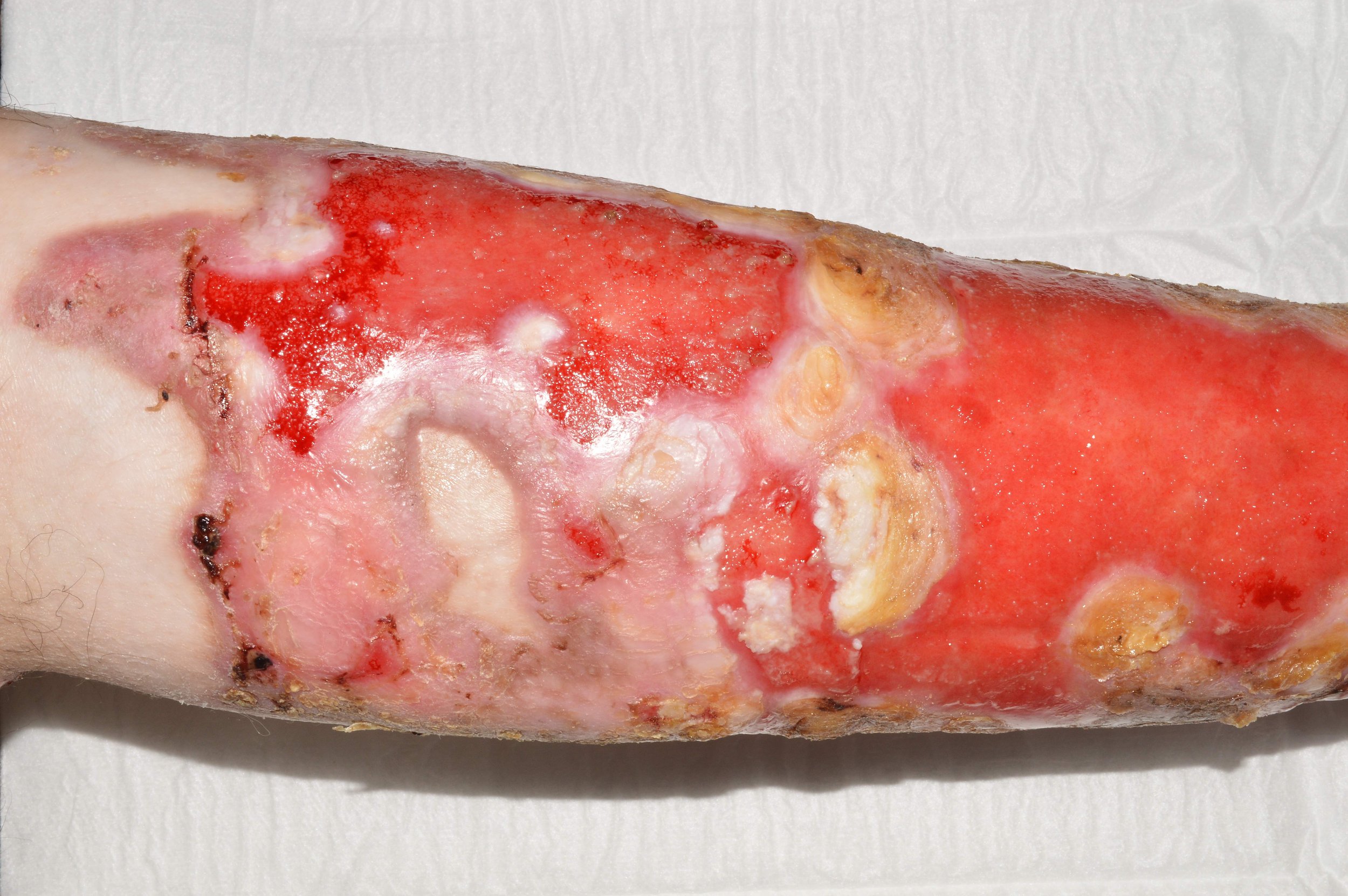RESOURCE MATERIALS
Papers
Current Clinical Trials
Bullous Pemphigoid
Bullous pemphigoid is a chronic blistering autoimmune disease of the skin. The occurrence of this disease rise considerably with age, and it mainly affects patients over 70 years old. With about 1-4 newly diagnosed patients per 100000 individuals per year, bullous pemphigoid is a rare condition.
Bullous pemphigoid is a sub-epidermal autoimmune blistering disease. “Bullous” means blistering and “pemphigoid” comes from the Greek word pemphix and means bubbles. Patients almost always suffer from severe itching accompanied by blistering on red or otherwise normal skin. The blisters contain a clear or bloody fluid and develop further into erosions and crusts when damaged, but they normally heal without scarring. In some patients blisters may only appear on some parts of the body and while in other patients the whole body can be affected.
There are two main layers of the skin, the epidermis (the very top layer) and the dermis (the deep layer). The area between these layers is known as the basement membrane zone. Bullous pemphigoid occurs when cells of the body’s immune system produce proteins (autoantibodies) which attack and damage specific proteins of the basement membrane zone (known as BP180 and BP230), which are critical in attaching the top layer of skin cells (the epidermis) to the underlying layer (the dermis). If the basement membrane proteins are damaged, the top and bottom layers of the skin separate, causing blister formation.
The cause of the immune attack on the skin is unknown. It may occur several years after damage to the nervous system or muscle system although how these events are related is unknown.
For Further information
Pemphigus Vulgaris
Pemphigus Vulgaris is a rare autoimmune blistering disease which is characterised by blisters, erosions and crusts in the mouth and on the skin. “Vulgaris” means “common” so this type of pemphigus is the most common form of the condition. Other forms of pemphigus include pemphigus foliaceus and paraneoplastic pemphigus.
Pemphigus Vulgaris occurs when cells of the body’s immune system produce proteins (autoantibodies) that damage the adhesion points between the skin cells. These adhesion points act like press studs holding the top layer of the skin cells (epidermis) together. If they are damaged, the skin cells break apart and are unable to form a proper barrier.
The cause of the immune attack on the skin is unknown. Genetic factors are thought to play a role. Pemphigus Vulgaris has been reported to occur worldwide but is more prevalent in people of Ashkenazi Jewish descent and those of Mediterranean origin.
For further information
insert pictures
Pemphigus Foliaceus
Pemphigus Foliaceus is a rare autoimmune blistering disease which is characterised by superficial blisters, erosions and crusts on the skin. This type of pemphigus is less common than pemphigus vulgaris in Australia but in some parts of the world it is “endemic” and very common.
Pemphigus Foliaceus occurs when cells of the body’s immune system produce proteins (autoantibodies) that damage the adhesion points between skin cells. These adhesion points act like press studs holding one of the top layers of the skin cells (epidermis) together. If they are damaged, the skin cells break apart and the top layer peels off. As the top layer is very thin, the blisters may not be noticed, and the skin may appear to be peeling only
Pemphigus Foliaceous usually affects the scalp, face, torso and armpits. The skin lesions usually are small, scattered blisters that rapidly evolve into scaly, crusted erosions. Occasionally, pemphigus Foliaceous may encompass the entire skin surface as an abnormal redness.
insert 2 pictures
\
For Further Information
Mucous Membrane Pemphigoid
Mucous Membrane Pemphigoid (MMP) is a chronic autoimmune disorder characterized by blistering lesions that primarily affect the various mucous membranes of the body, but also affects the skin. Mucous membrane pemphigoid, previously known as cicatricial pemphigoid, is a very rare sub-epidermal autoimmune blistering disease which predominantly affects the mucous membranes such as the inner linings of the mouth, eyes and genitalia. The second part of its name, “pemphigoid”, comes from the Greek word pemphix, meaning bubbles. The incidence of mucous membrane pemphigoid is approximately 1.3 to 2.0 new cases per million people per year.
There are two main layers of the skin, the epidermis (the very top layer) and the dermis (the deep layer). The area between these layers is known as the basement membrane zone. Mucous membrane pemphigoid occurs when cells of the body’s immune system produce proteins (autoantibodies) that attack and damage the basement membrane zone. If these components are damaged, the two layers of the mucosal epithelium (body linings) break apart, causing blister formation. What causes the immune attack on the epithelium is unknown.
For Further Information
Pemphigoid Gestationis
Pemphigoid Gestationis (PG) is a rare autoimmune bullous dermatosis of pregnancy. Pemphigoid Gestationis typically manifests during late pregnancy, with an abrupt onset of extremely pruritic urticarial papules and blisters on the abdomen and trunk, but lesions may appear any time during pregnancy, and dramatic flares can occur at or immediately after delivery. The mother’s immune system mistakenly forms anti-skin antibodies which destroy molecules in the zone between her skin’s epidermis (first layer of the skin) and dermis (second layer of the skin) and create a blister. Pemphigoid Gestationis usually resolves spontaneously within weeks to months after delivery.
For Further Information
Epidermolysis Bullosa
Epidermolysis Bullosa (EB) is a group of rare inherited skin fragility disorders which are characterised by blistering of the skin and peeling at the lightest touch. EB is a genetic disease. So far, mutations in 19 different genes have been identified as causes for EB. These EB genes produce proteins that are responsible for holding the skin and linings of the body together. Mutations in these genes cause the proteins to be weak or even absent resulting in skin fragility and blistering with minor injury.
EB may be inherited in an autosomal dominant pattern from one parent who already has EB. In these cases there is a 50% chance of the affected parent passing this type of EB onto the child. EB can also be inherited in an autosomal recessive pattern, if both parents are carriers for the condition. Parents who are carriers for EB do not have symptoms of the condition. If both parents are carriers for the same type of EB, there is a 25% chance that their child will develop the condition. EB can also occur spontaneously where there is no family history of EB and neither of the parents are carriers for the condition.
EB is characterised by skin fragility with blister formation occurring spontaneously or following minor trauma. EB can be broadly divided into four major categories: Simplex, Junctional, Dystrophic and Kindler Syndrome.
For further information













